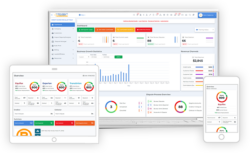Today’s business decisions require thorough analysis and prior research as business organisations are becoming increasingly complex. Financial planners and strategists have to consider a multitude of factors including market conditions or the current GDP, analyse them and conduct an extensive research to predict their impact before developing business strategies.
Technology has facilitated this process by developing various tools or software that make the analysis swifter and more accurate. Financial modelling is one of these technological aids that help businesses make smarter decisions.
If you want to know more about the concept of financial modelling, this blog is for you. It breaks down the definition of the concept, lists the areas it can be used and the future scope of a career in the subject.
What is financial modelling?
Financial modelling involves using excel spreadsheets or similar software to create a summary of an organisation’s expenses and revenue. These spreadsheets can be used to interpret useful data as the net income or the impact of a financial decision.
You can also view financial modelling as a numerical representation of the company operations. This method is extensively used to
- Valuate a business
- Calculate the costs of new projects
- Prepare budgets or allocate resources
- Develop strategic plans to test new growth models
Types of financial models
Financial models vary in type and complexity from a single sheet model to calculate the profits per day to multi-sheet multi-user workbooks to monitor several factors simultaneously. Here are the different types of financial models.
• Discounted Cash Flow model (DCF): DCF analysis provides the current net value of a company by analysing the company cash flow in the past and present and predicting future cash flows.
• Leveraged Buyout model (LBO): If an organisation is in debt, the analysts utilise this approach to estimate if the business is likely to sustain the debt and the revenue generation required to repay all outstanding dues.
• Mergers and Acquisition model (M&A): The M&A model is used to understand the economic impact of a recent acquisition on the parent company. If the estimated impact is positive, the acquisition is known as ‘accretive’ and the opposite situation is known as ‘dilutive.’
• Comparable company analysis: This model compares the financial metrics of a company against the gold standard in the industry to assess the company’s position. The model is based on the assumption that other organisations in the industry also have similar standards.
• Credit rating model: Credit analysts use this method to examine the creditworthiness of a company. The model takes into account all the profit margins, current debt and the amount of debt repaid until the present day.
Where is financial modelling used?
Financial and corporate analysts regularly use financial modelling to fulfil the following tasks.
- Capital, debt or equity calculations and allocations
- Mergers and acquisitions
- Sell and purchases of business units
- Budgets and forecasts planning for each financial year
- Calculation of the organic growth percentage of a business
- Business asset valuations
Employment opportunities of a degree in financial modelling
Financial modelling graduates can secure a job in any business or industry. However, the most common career paths chosen by these graduates are investment banking, corporate development, equity research, and financial planning and analysis (FP&A).
Here are a few positions that are open to you if you want to pursue financial modelling as a career.
- Financial analysts
- Merger and acquisition associates
- Junior FP&A managers
- Investment banking associates
- Debt management associate
- Commercial/retail banking associate
Apart from these positions, you can utilise your skills in the subject in any domain that has a financial aspect such as medicine, engineering, and media.
Owing to the future scope of the subject, many universities offer well-structured financial modelling courses online or offline. You should consider choosing a course that is offered by a reputed university with an excellent faculty and practical-based approach to teaching the subject.




